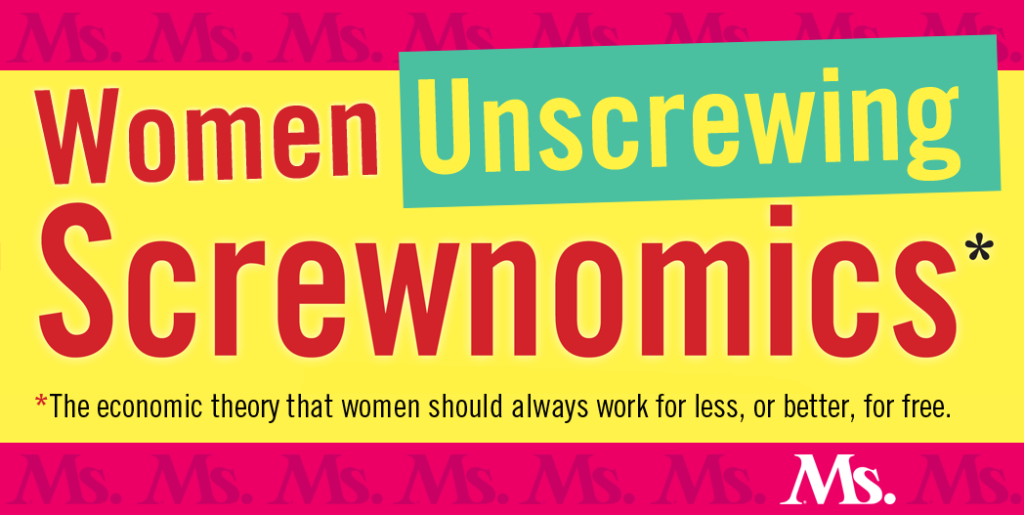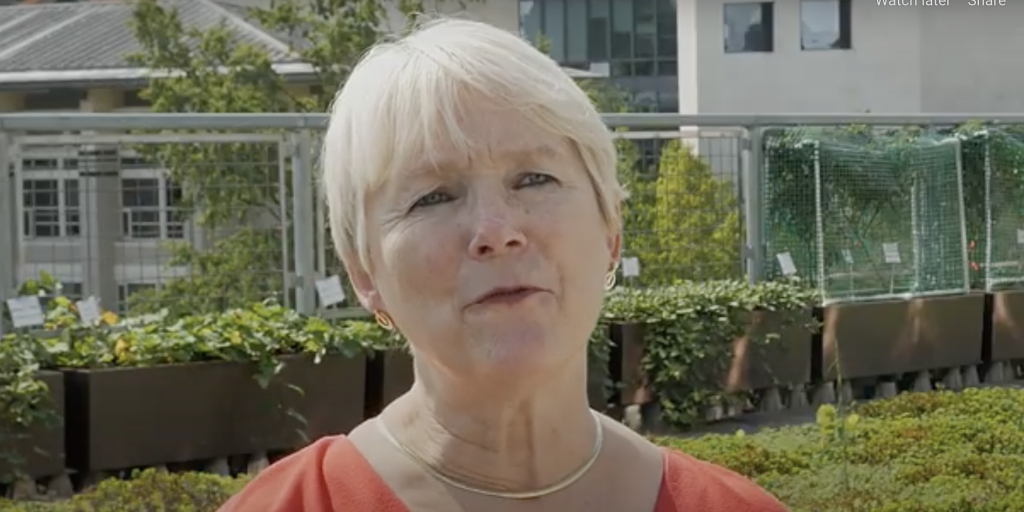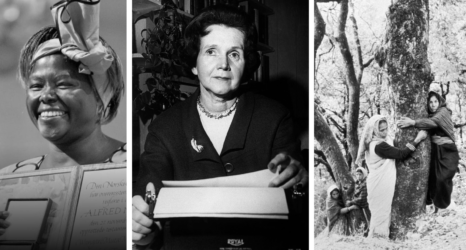“Wouldn’t that be something if we thought about the whole economy that way and built restoration and care in by design at the front end?”

It’s time to talk about women’s economics with attitude. It’s time to laugh at what is often absurd and call out what is dangerous. By focusing on voices not typically part of mainstream man-to-man economic discourse, Women Unscrewing Screwnomics will bring you news of hopeful and practical changes and celebrate an economy waged as life—not as war.
In 1918, an article in The Syracuse Herald first used a now common “sink” expression to describe an all-out good effort. By WWII, we liked to say we “threw everything but the kitchen sink” at our enemy, the fascist powers. Today, sinks are in the news again, but not usually the one in your kitchen. We should change that.
A carbon sink can be an ocean or a forest, a rock or a human being—the same things that can also be a carbon “source,” the opposite of a sink. Whether something functions as a source or a sink depends, say life scientists, on how you manage the ocean, the forests, the rocks, or us humans. Because we’ve been burning carbon for 200 years, we’ve sourced too much of it into the atmosphere in the form of CO2. The planet is warming, weather’s disruptive, and species are falling like dominoes.

Dr. Sabine O’Hara, the distinguished economist and founding dean of the College of Agriculture and Urban Sustainable Environmental Science (CAUSES) at the University of the District of Columbia, says economists have appropriated many science words like “source,” and “resource” but conveniently have forgotten the sink. Instead, she said, “We call them an ‘externality.’ I find this term very telling—it’s somebody else’s problem.”
In a recent interview with Ms. about her latest work—which she’s calling restorative economics—O’Hara said what interests her most these days is our sink functions. “These have to be maintained, like resources have to be maintained. We draw down water, and rain replenishes, but over time we have diminishing amounts; diminishing returns happen with soil, too. Eventually resources are gone. What became intriguing for me was: What happens to sink functions? Can they be depleted too?”
Her research currently centers on CAUSES’s urban food hubs in Washington D.C., which she explains have four components: first, growing food in the urban scape; secondly, processing food while teaching about nutrition. Thirdly, the hubs experiment with new distribution models. And most importantly, they collect data on the sink function: How can we close the loops of waste and depletion with water management and soil enhancement, bioenergy generation, and water capture? The hubs’ research collects data on all these re-circulating systems.
Like another woman academic from England’s Oxford University, Kate Raworth, who wrote Doughnut Economics; 7 Ways to Think Like a 21st Century Economist, O’Hara is seeking to reshape today’s neoliberal free market ideas. Both economists think it wiser to better match Mother Nature, whose systems are not linear and open-ended, and surely not external to planet Earth, but circular and complex. O’Hara says that while Raworth got tired of talking to other economists and decided to write for the public, she’s still writing for economists, seeing their influence and a need for new systemic thinking.
For the young woman who avoids economics because some things in it don’t make sense to her, O’Hara says that might be because it doesn’t make sense. She urges young women to dare enter this still male-dominated field and say so. She currently leads an innovative Ph.D. program in urban leadership and entrepreneurship.
O’Hara’s restorative economics, like Raworth’s “doughnut economics,” would widen the lens beyond markets, money and numbers to include the economy’s living contexts. This requires a closer and more intense study of sink functions, which O’Hara emphasizes includes you and me.
For her, a wake-up moment came early when she began working in agriculture, food production still her strong interest. In the early ’60s, nuclear testing had been resumed, and a radioactive isotope, Strontium 90, was found stored in mothers’ breast milk.
“It’s really about more broadly looking at ecosystem services,” said O’Hara. “Initially, the U.N. defined categories and it was the environment and the economy. Thankfully we now see the economy is nested in a culture within a society, which in turn is nested in the environment and nature. Our communities are sinks; our families are too. So, what we’re running out of—maybe it’s not just the resources diminishing, but we’re running out of the sink capacities, too. The planet is running out of its sink capacities.”
For example, peatlands are the Earth’s greatest carbon sink but when damaged or affected by climate change or drained, they begin releasing carbon. Coastal wetlands are another valuable sink being damaged by storms and rising seas. But O’Hara also said:
“Definitely some of our communities, who have borne the brunt of dealing with emissions and waste and storms, they are also seeing their capacities exhausted, their people overloaded, right? It’s women who have historically contributed to that restorative sink work. If you don’t get fed, if you don’t sleep, if you don’t get love, where’s your productivity going to come from to go to work the next day? Economists always paid attention to the source work for production, but not to the sink work, or my new terminology, the restorative work.”
O’Hara’s food hubs—with their four components of producing, processing, distributing and closing the loop—are intended to model how the whole economy could function. Her restorative goal is to minimize emissions and waste, to reuse as much as possible. “This is built in by design. It’s not an afterthought,” she said. “Wouldn’t that be something if we thought about the whole economy that way and built restoration and care in by design at the front end?”
“Restorative,” O’Hara’s word for this holistic and rounded thinking, carries with it more emotional connotations than a stainless-steel technical term like sink, or worse, economic externalities. Restorative says what everyone knows; economic activity is not all rainbows and unicorns.
She said, “So the enlightened few suggest we need to put a price on these externalities and re-internalize them so that the market is corrected. I would suggest to you, that’s not where it’s at. How about we internalize how nature works into the economy? How about we figure out how nature works, instead of trying to make nature do what we want it to do for the economy?”
The need for greater understanding of how sinks work is the reason she also proposes that land grant universities like hers undertake a national research project on sink functions. Although UDC is the only urban land grant institute in the nation, a network of 100 land grant universities provides Cooperative Extension Services. Created in 1914 to provide scientific guidance to rural America’s farmers, these bring informal education to the larger public. Imagine cooperative research into closing the loop and education about recovery.
“I am very worried coming out of COVID,” said O’Hara. “We have a chance to say, okay, so what didn’t work, right? We learned that we have an essential workforce, the people we all depend on who are paid a pittance; that has to change. We’ve learned about the liability of long supply chains; so how can we relocate things to make those supply chains less vulnerable? But I don’t hear any of that. All I hear is, ‘Oh, we’re opening things up,’ like we can consume our way out of this economic slump. No, we cannot.”
“I am very worried coming out of COVID … All I hear is, ‘Oh, we’re opening things up,’ like we can consume our way out of this economic slump. No, we cannot.”
The word restorative reminds us that free-market global capitalism has come unmoored from older, traditional wisdom. Instead of being thrifty, we are urged to consume. Instead of caring for our neighbor, we pursue a mirage of self-sufficiency, which denies our utter dependence at the beginning and ending of everyone’s life, and in between, our human need for connection and belonging.
O’Hara points out that Adam Smith, considered the father of modern economics, said the market only works efficiently within a moral fence. “For him as a good Calvinist, the fence demanded compassion. So, within that moral fence, the market is a tremendously efficient allocation mechanism. But when we lose sight of that moral fence, we’re in trouble. That’s what policy needs to focus on. That moral fence needs to look both at people and at nature.”
By contrast, we’re more likely to be urged to “capture” carbon or “sequester” it—in sinks, of course. But language shapes how we think about things. These terms coined mostly by men seem part of our problem of failing to quickly cook up some all-out efforts to end global environmental collapse.
To “capture” implies we’re at war with carbon, the very stuff of life. To “sequester” is to confiscate property from a debtor who owes you. But who exactly are the real debtors here? When have you ever sequestered anything?
About as often as you’ve thrown a sink, I’ll bet. Yet throwing a sink or restoring it seems far more carthartic than capturing or sequestering or externalizing the crisis we’re in. New language might even result in more all-out good faith action.
Up next:





